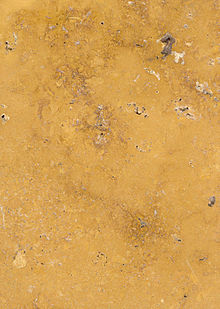Cannstatter travertine
The Cannstatter travertine is a Süßwasserkalk.
Origin and composition
The Cannstatter Travertine is a more or less porous limestone of light, mostly yellowish to brown color. The Cannstatter Travertine originated in the warm periods of the Pleistocene at the Cannstatter and Stuttgart mineral springs. It is superimposed on various old terraces of the Neckar. The occurrences are between 500,000 years and 5000 years old. When the highly calcareous mineral waters from the subterranean shell limestone layers in the Neckar floodplain reach the surface, CO 2 escapes and the limestone precipitates. That is why the rock consists almost exclusively of calcium carbonate . The beautiful warm yellow and brown color is caused by small admixtures of the mineral limonite .
Technical characteristics and use
This travertine is porous and interspersed with cavities. When it was made, it included plants and parts of plants that were then broken down and decomposed. The resulting cavities often show an imprint of the plant parts. In break fresh state of travertine can be crafted easily edit because it is soft and only gradually hardens. This natural stone can be polished. The polish will dwindle outdoors due to the currently prevailing acidic environmental conditions. Cannstatter travertine is frost-resistant despite the high water absorption when it is sawed against the bearing. When sawing open or installing with or against the bearing, Cannstatter Travertine shows different impermeability and color. Installed against the bearing, it is lighter and more porous, and with the bearing it is darker and denser. Its suitability as a building block, for facades, door and window frames has proven itself. It is traded open-pored or filled.
Its occurrence is located in the district of Bad Cannstatt in Stuttgart . The quarries were closed in 2007 and the site was converted into the Stuttgart Travertine Park.
Buildings
IG-Farben-Haus Frankfurt am Main (33,000 m² facade panels made from Cannstatt travertine)
The " Lauster pillars " were to be built in monumental form in the Reich capital Berlin during the Nazi era
Midnight building office and commercial building in Stuttgart
Travertine plinth for Henry Moore , Die Liegende (1961) on the forecourt of the Neue Staatsgalerie Stuttgart
Part of the outer wall of the Wilhelma in Stuttgart
Columns of the arcade courtyard of the St. Fidelis Church in Stuttgart
See also
Web links
- Images of Cannstatter Travertine in different colors
- Travertine park in Stuttgart-Bad Cannstatt near the state capital Stuttgart
- Travertine Park - Window into prehistoric times (PDF; 6.7 MB)
literature
- Johannes Baier: The Cannstatter Travertine . - In: Aufschluss , Vol. 71, 144–153, 2020.
- Dietmar Reinsch: Natural stone studies. An introduction for civil engineers, architects, preservationists and stonemasons , Enke, Stuttgart 1991










